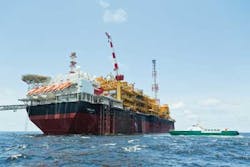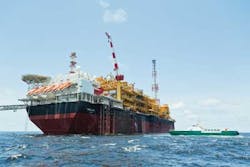Total adopts all-electric, subsea multi-phase approach for mixed-crude CLOV development
Jeremy Beckman
Editor, Europe
In June, Total lifted first oil fromCLOV, its fourth deepwater development "pole" in block 17 offshore Angola. Like its predecessors Girassol, Dalia and Pazflor, CLOV routes production through a network of subsea flowlines to a spread-moored FPSO. Total took onboard experiences from these earlier projects to address certain issues, notably the treatment of two different types of crude. But CLOV also features innovations designed to improve recovery and operational efficiency, as well as raising the bar in terms of local construction content.
The development takes in the Cravo, Lirio, Orquidea, and Violeta fields, with proven and probable oil reserves of 505 MMbbl. The fields cover 381 sq km (147 sq mi) in water depths of 1,100-1,400 m (3,609-4,593 ft), 140 km (87 mi) from Luanda, and 40 km (25 mi) northwest of the Dalia hub. Reservoir conditions vary, with different temperatures, pressures, and oil qualities. The Oligocene Cravo and Lirio reservoirs produce 32-35°API crude which quality-wise is one of the best in block 17. Orquidea and Violeta's Miocene produces 20-30° API oil, which is more permeable and viscous.
Development drilling started in 2012. Total and its partners Statoil, ExxonMobil, and BP plan to tie a total of 34 wells back to the FPSO, which has oil processing capacity of 160,000 b/d, storage for up to 1.8 MMbbl, and gas handling capacity of 230 MMcf/d (6.5 MMcm/d). Engineering, procurement, and construction contractor Daewoo Shipbuilding & Marine Engineering (DSME) cut first steel in July 2011 and completed the vessel two years later. Construction required supply of about 88,000 steel plates, supplied by POSCO.
KBR performed detailed engineering and design of the topsides in collaboration with DSME.
The vessel is designed to process and store the different types of crude simultaneously, while its hull incorporates tanks to separate the produced oil from water. DSME contracted VWS Westgarth to design and supply ultra-filtration equipment with a capacity of 66,208 cu m/d (2.34 MMcf/d), and a sulfate removal package with treatment capacity of 59,496 cu m/d (2.1 MMcf/d). Grenland Group provided the vessel's Minox deoxygenating system which can treat up to 280,000 b/d of water used for injection, while Sulzer engineered the electric motors for the water injection pumps.
This is Total's second all-electric FPSO and its first to be equipped with variable-speed drive (VSD) systems to help control energy consumption. The configuration is designed to maximize energy efficiency by generating only the quantity of electricity needed to operate the facilities. Under a $113-million contract, GE supplied four LM2500+ G4 SAC aero-derivative gas turbines for power generation and five gas compressors, while GE subsidiary Converteam manufactured five VSD systems, including induction motors, for the compressors. During normal operations there is no flaring, with recovery of heat from the turbine exhausts and of vent gases.
CLOV's processed crude is transferred regularly to tankers via two 2-km (1.2-mi) long reinforced rubber oil offloading lines (OOLs) connected to an offshore loading buoy. Total claims that the wider than normal diameter of the OOLs (24-in.) allows the crude to be transferred directly in the allotted transfer time, dispensing with the normal booster pumps. According to Cyril de Coatpont, in charge of CLOV's subsea pipeline/oil offloading systems, the pipes, which are designed for a service life of up to 20 years, can cope with pressures up to 30 bar (435 psi). "They have to be reinforced to be able to withstand the water 'hammers' that can accidentally occur during offloading operations." To meet these specifications, OOL designer and manufacturer Trelleborg in France tightened the manufacturing procedures, increasing the number of crossed metal frames between the various layers of rubber that make up the pipes.
CLOV's produced gas is exported via a subsea pipeline to the onshore Angola LNG plant.
Displaying 1/2 Page 1,2Next>
View Article as Single page
About the Author
Jeremy Beckman
Editor, Europe
Jeremy Beckman has been Editor Europe, Offshore since 1992. Prior to joining Offshore he was a freelance journalist for eight years, working for a variety of electronics, computing and scientific journals in the UK. He regularly writes news columns on trends and events both in the NW Europe offshore region and globally. He also writes features on developments and technology in exploration and production.


